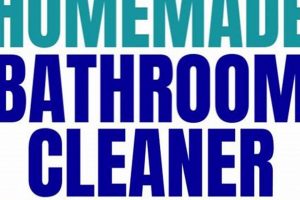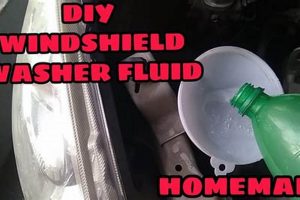A homemade cleaning agent, typically in granular form, intended for washing clothes in a machine or by hand. It generally comprises ingredients such as washing soda, borax, and soap flakes, combined to create a cleansing solution that is more economical and potentially gentler than commercially produced alternatives. A common formulation involves grating a bar of natural soap and blending it with sodium carbonate and sodium borate.
Creating this type of cleaning product offers several advantages, including cost savings, control over ingredients (allowing for avoidance of allergens or harsh chemicals), and reduced environmental impact due to less packaging and the option to use biodegradable components. Historically, similar cleaning methods were prevalent before the widespread availability of mass-produced detergents, relying on readily available minerals and natural soaps.
The subsequent sections will delve into the specific ingredients used in these formulations, detailing their individual roles and potential substitutes. Furthermore, guidance will be provided on crafting effective recipes, ensuring proper usage within various washing machines, and addressing common issues that may arise during the creation or application of these homemade cleansers.
Tips for Formulating Effective Laundry Cleanser
The following tips provide guidance on creating a suitable and effective homemade laundry cleaning agent. Adherence to these recommendations will improve the likelihood of successful and satisfactory cleaning results.
Tip 1: Ingredient Quality Matters. Utilize high-quality ingredients, particularly when selecting soap. Natural soaps without added fragrances or dyes are preferable to minimize potential skin irritation and allergic reactions.
Tip 2: Washing Soda is Crucial. Sodium carbonate, or washing soda, acts as a water softener and helps to lift dirt. Ensure the correct quantity is used, as excessive amounts can damage fabrics over time.
Tip 3: Borax Enhances Cleaning Power. Sodium borate, commonly known as borax, serves as a cleaning booster and stain remover. While effective, its use is subject to debate regarding potential environmental concerns, warranting careful consideration.
Tip 4: Gradual Incorporation of Ingredients. When mixing the components, gradually incorporate each ingredient, ensuring thorough blending for a uniform consistency and optimal performance.
Tip 5: Storage Considerations. Store the finished cleaning agent in an airtight container in a cool, dry place to prevent clumping and maintain its effectiveness. Moisture can degrade the product.
Tip 6: Dosage is Key. Use the appropriate dosage for each load size. Overuse can leave residue on clothing, while underuse may result in inadequate cleaning. Start with a small amount and adjust as needed based on laundry conditions.
Tip 7: Test on a Small Area. Before washing an entire load, test the cleanser on a small, inconspicuous area of a garment to ensure colorfastness and compatibility with the fabric.
Tip 8: Water Temperature Awareness. Different water temperatures may affect the solubility and effectiveness of the cleaning agent. Adjust the recipe or usage accordingly based on the water temperature.
By following these guidelines, individuals can create a cost-effective and environmentally conscious cleaning solution that effectively cleanses laundry while minimizing potential risks associated with commercial detergents.
The subsequent conclusion will summarize the key advantages and considerations associated with using homemade laundry cleaning agents, providing a comprehensive overview of the subject.
1. Ingredient Sourcing
The selection of components fundamentally influences the overall environmental and ethical profile of homemade laundry cleaning agent. Sourcing practices determine the sustainability, potential toxicity, and social responsibility aspects of the final product. Choices made during ingredient acquisition have a direct causal relationship with the ecological footprint and consumer safety associated with its creation and use. For instance, opting for palm oil-derived soap flakes contributes to deforestation and habitat loss, while selecting sustainably harvested plant-based oils mitigates these negative effects. Similarly, the extraction methods employed for washing soda and borax can impact water quality and ecosystem health.
The origin and manufacturing processes of each ingredient exert considerable influence on the cleanliness and gentleness of the cleaning agent. The decision to purchase washing soda processed using energy-efficient methods, versus those reliant on fossil fuels, exemplifies this impact. Transparency regarding the source and processing details of ingredients empowers consumers to make informed choices aligned with their environmental and ethical values. For example, a cooperative of shea butter producers in West Africa, committed to fair labor practices and environmentally sustainable harvesting, provides an alternative to mass-produced, less ethically sourced alternatives often found in commercial products. This consideration extends to the packaging materials used, favoring recyclable or compostable options over single-use plastics.
In summary, deliberate ingredient sourcing constitutes a crucial step in maximizing the benefits and minimizing the adverse impacts of making homemade laundry cleaning products. By prioritizing suppliers committed to environmental sustainability, ethical labor practices, and transparent sourcing, consumers contribute to a more responsible and environmentally conscious laundry routine. This commitment to conscientious ingredient selection directly translates into a cleaning solution that reflects individual values and minimizes potential harm to both human health and the planet. The challenge lies in identifying reliable and transparent suppliers who can consistently provide responsibly sourced ingredients at accessible prices.
2. Formulation Ratios
The effectiveness of homemade laundry cleaning agent is intrinsically linked to the precise balance of its constituent ingredients. Formulation ratios dictate the cleaning power, fabric safety, and overall performance of the final product. Deviations from recommended proportions can lead to ineffective cleaning, residue buildup on clothing, or even damage to fabrics or washing machines. For example, an insufficient amount of washing soda (sodium carbonate) in the mixture may result in inadequate water softening, hindering the removal of dirt and stains. Conversely, an excessive concentration of borax (sodium borate) could potentially irritate sensitive skin or, over prolonged use, degrade certain fabric types. The ratio of soap to other ingredients directly impacts the cleaning agent’s ability to emulsify and remove greasy soils; too little soap leaves residue, while too
much can lead to excessive suds, particularly in high-efficiency washing machines.
Understanding the role and interaction of each component is paramount for formulating a cleaning agent tailored to specific needs and conditions. Water hardness, for example, influences the optimal ratio of washing soda; harder water requires a higher concentration to effectively neutralize mineral ions that interfere with detergent action. The type of washing machine also dictates appropriate ratios, as high-efficiency (HE) machines require low-sudsing formulations to prevent damage and ensure proper operation. Practical application involves careful measurement and mixing of ingredients according to established recipes, followed by gradual adjustments based on observed results. Documenting the quantities used and the resulting performance allows for fine-tuning the formulation to achieve optimal cleaning efficacy under specific conditions. The formulation process necessitates a basic understanding of chemistry, particularly regarding pH levels and the interaction of alkaline and acidic substances. A pH level that is either too high or too low can compromise the cleaning agent’s effectiveness or pose a risk to fabrics.
In summary, formulation ratios are not arbitrary values, but rather the cornerstone of successful homemade laundry cleaning agent creation. They represent a careful balance between cleaning power, fabric safety, and environmental impact. The challenges lie in accurately measuring ingredients, understanding the specific needs of the laundry environment (water hardness, machine type), and iteratively refining the formulation to achieve optimal results. By prioritizing precision and careful observation, individuals can create a cost-effective and environmentally conscious cleaning solution that effectively cleanses laundry without compromising fabric integrity or posing risks to human health or the environment. The subsequent sections will examine the influence of water hardness, machine compatibility and residue minimization on overall cleaning performance and user satisfaction.
3. Water Hardness
Water hardness, defined by the concentration of dissolved minerals such as calcium and magnesium, exerts a significant influence on the effectiveness of homemade laundry cleaning agent. The interaction between these minerals and the cleansing agents dictates the amount of cleaning product required, the potential for residue buildup, and the overall efficiency of the washing process.
- Reduced Cleansing Efficacy
Hard water ions impede the action of surfactants found in homemade formulas. These ions bind to soap molecules, forming insoluble precipitates known as soap scum. This precipitation reduces the concentration of available surfactants, diminishing the cleaning agent’s ability to emulsify and remove dirt and grease from fabrics. The result is that clothes may not be cleaned effectively, necessitating the use of more cleaning agent to achieve desired results.
- Increased Cleaning Agent Consumption
Due to the reduced efficacy, a greater quantity of cleaning agent is needed in hard water to compensate for the mineral interference. This increased consumption elevates the overall cost of laundry and may exacerbate potential environmental impacts associated with the production and disposal of cleaning product ingredients. Overuse can lead to an accumulation of insoluble residues within the washing machine and on the fabric itself.
- Residue Buildup on Fabrics and Machines
The aforementioned soap scum, formed by the interaction of hard water minerals and soap, adheres to fabric fibers and internal components of washing machines. This buildup causes clothing to feel stiff and appear dull, and can reduce the efficiency of washing machines by clogging pipes and reducing heating element performance. Over time, the accumulation of mineral deposits within the machine necessitates more frequent and thorough cleaning to maintain optimal functionality.
- Impact on Ingredient Selection
The prevalence of hard water necessitates careful selection of ingredients within the homemade laundry cleaning agent formulation. Ingredients like washing soda (sodium carbonate) are often included to soften the water by precipitating out the calcium and magnesium ions. The amount of washing soda required is directly proportional to the hardness of the water; therefore, individuals must adjust their recipes based on local water conditions to achieve optimal performance.
The interplay between water hardness and homemade laundry cleaning agent underscores the importance of understanding local water conditions and tailoring formulations accordingly. Effective strategies for mitigating the effects of hard water include the incorporation of water softening agents, the use of higher concentrations of cleaning product, and the implementation of regular machine maintenance to remove mineral deposits. Failure to address water hardness can result in suboptimal cleaning performance, increased cleaning product consumption, and potential damage to both fabrics and washing machines.
4. Machine Compatibility
The compatibility of homemade laundry cleaning agent with various washing machine types represents a crucial consideration for effective and damage-free operation. Different machine designs, particularly standard top-loading and high-efficiency (HE) models, exhibit varying requirements regarding suds levels, water usage, and cleaning agent concentration. Failure to account for these differences can result in suboptimal cleaning performance, machine malfunction, or even voided warranties.
- Suds Level and HE Machines
High-efficiency washing machines, both top-loading and front-loading, are engineered to use significantly less water than standard machines. Excessive suds interfere with the washing action in HE machines, reducing cleaning effectiveness and potentially triggering error codes or pump failures. Homemade cleaning agents formulated with high-sudsing soap can create this problem. Low-sudsing soap varieties or careful control of soap concentration are necessary to maintain machine compatibility.
- Dispensing Systems and Granule Size
Many washing machines feature automatic dispensing systems for laundry detergents. The particle size and solubility of homemade cleaning agent influence its ability to be effectively dispensed by these systems. Large or poorly soluble granules can clog dispensers, preventing the cleaning agent from being properly distributed during the wash cycle. Thorough mixing and the use of finely grated or powdered ingredients are recommended to ensure compatibility with dispensing systems.
- Material Compatibility and Corrosion
Certain ingredients commonly found in homemade cleaning agent, such as sodium carbonate (washing soda), can be corrosive to specific materials used in washing machine construction. Prolonged exposure to high concentrations of these substances may damage seals, hoses, or other components, leading to leaks or premature machine failure. The appropriate dilution and controlled usage of potentially corrosive ingredients are crucial for preserving machine integrity.
- Water Temperature and Dissolution
The solubility of homemade cleaning agent ingredients varies depending on water temperature. In
cold water, some ingredients may not fully dissolve, leading to undissolved particles remaining on clothing or accumulating within the washing machine. Ensuring adequate water temperature for dissolution, or pre-dissolving the cleaning agent in warm water before adding it to the machine, can improve its effectiveness and prevent residue buildup.
The preceding considerations underscore the importance of tailoring homemade cleaning agent formulations to the specific requirements of the washing machine being used. A thorough understanding of machine capabilities and limitations, coupled with careful ingredient selection and controlled usage, promotes both optimal cleaning performance and the longevity of the appliance. Neglecting machine compatibility can result in both short-term inconveniences and long-term equipment damage, negating the potential cost savings associated with making homemade cleaning products. Experimentation should proceed cautiously, with close observation of machine performance and any potential adverse effects.
5. Residue Minimization
Residue minimization constitutes a critical performance parameter of homemade laundry cleaning agent. The presence of residue on laundered items negates several intended benefits of creating such cleaning solutions, including cost savings, reduced skin irritation, and environmental considerations. Residue arises from several factors inherent in formulation and usage, impacting fabric feel, cleanliness, and potential for allergic reactions. Insufficient rinsing, overuse of cleaning agent, or the inclusion of insoluble ingredients are primary causes. For example, excess soap, particularly in hard water, interacts with minerals to form insoluble curds that deposit on clothing, leaving a stiff or scratchy texture. These deposits not only diminish comfort but can also trap dirt and odors, ultimately reducing the effectiveness of the wash.
The formulation of homemade cleaning solutions necessitates a balanced approach to ensure residue minimization. Washing soda, while effective in softening water, can contribute to residue if not fully dissolved or if used in excessive quantities. Borax, another common ingredient, may leave a white powdery film on dark fabrics under similar conditions. The type of soap employed also plays a significant role; natural soaps often contain unsaponified oils that can leave a greasy residue, particularly in cold water washes. Practical mitigation strategies involve using the minimum effective amount of cleaning agent, optimizing water temperature to enhance solubility, and incorporating a vinegar rinse cycle to neutralize alkaline residues and improve rinsing. Choosing finely powdered or liquid ingredients, where possible, also reduces the likelihood of undissolved particles contributing to residue buildup.
In conclusion, residue minimization is not merely an aesthetic concern but a functional requirement for successful application of homemade laundry cleaning solutions. Understanding the chemical interactions between ingredients, water hardness, and fabric types is essential to formulating effective and residue-free cleaning products. Challenges remain in achieving consistent results across diverse laundry conditions, but a focus on precise measurement, proper ingredient selection, and optimized washing techniques significantly improves the likelihood of achieving clean, fresh laundry without compromising fabric integrity or user comfort. Future improvements may involve developing more readily soluble formulations or incorporating enzymes to break down potential residue components.
6. Storage Conditions
The efficacy and longevity of homemade laundry cleaning agent are directly contingent upon the prevailing storage conditions. Improper storage exposes the compound to moisture, temperature fluctuations, and air, each of which catalyzes degradation processes that compromise its intended performance. Hygroscopic ingredients, such as washing soda and borax, readily absorb moisture from the atmosphere. This absorption results in clumping, caking, and a reduction in the cleaning agent’s solubility. Consequently, the end user encounters difficulty in dispensing the correct amount, potentially leading to ineffective washing or, conversely, the overuse of the product in an attempt to compensate for reduced solubility. Furthermore, prolonged exposure to humidity encourages the growth of mold and bacteria, rendering the cleaning agent unsuitable for use due to hygiene concerns and potential fabric contamination.
Sunlight and elevated temperatures also induce undesirable changes in the cleaning agent’s composition. Ultraviolet radiation, a component of sunlight, accelerates the degradation of certain organic components, such as soap flakes, diminishing their cleaning power. High temperatures, exceeding 30C (86F), promote the volatilization of volatile ingredients, altering the intended chemical balance of the formulation. Consider a scenario where a batch of homemade cleaning agent is stored in a garage subject to significant temperature swings and humidity variations. Over time, the product transforms from a free-flowing powder to a hardened mass, necessitating significant effort to break it apart for use. This degradation not only inconveniences the user but also diminishes the cleaning agent’s overall effectiveness, potentially leading to unsatisfactorily laundered clothing. To mitigate these effects, airtight containers composed of opaque materials are essential. These containers restrict moisture infiltration, shield the cleaning agent from sunlight, and maintain a relatively stable temperature environment.
In conclusion, proper storage constitutes an indispensable element in maximizing the benefits of crafting homemade laundry cleaning solutions. The challenges associated with improper storage extend beyond mere inconvenience, impacting the product’s cleaning efficacy, hygiene, and overall longevity. By adhering to recommended storage practicesutilizing airtight, opaque containers in cool, dry locationsindividuals can preserve the quality and effectiveness of their homemade cleaning agents, ensuring consistent and satisfactory laundry results while minimizing potential risks associated with product degradation. The emphasis on appropriate storage conditions underscores the importance of viewing the creation of homemade cleaning solutions as a holistic process encompassing not only formulation but also preservation.
Frequently Asked Questions
The following addresses common inquiries regarding the creation, application, and performance of homemade laundry cleaning agent. Each question is answered concisely, providing factual information without colloquialisms or subjective opinions.
Question 1: What are the core ingredients necessary for formulating effective homemade laundry cleaning agent?
Essential components typically include washing soda (sodium carbonate) for water softening and stain removal, borax (sodium borate) as a cleaning booster and disinfectant, and soap flakes (derived from natural oils) for emulsifying and removing dirt.
Question 2: How does water hardness affect the performance of this homemade cleaner, and what adjustments are needed?
Hard water, containing high levels of minerals, reduces the cleaning agent’s efficacy. Increased amounts of washing soda are necessary to neutralize these minerals. A vinegar rinse cycle assists in removing mineral deposits and soap
scum.
Question 3: Can this type of laundry cleaning agent be safely used in high-efficiency (HE) washing machines?
Yes, provided that the formulation is low-sudsing. Excessive suds interfere with the operation of HE machines. Careful ingredient selection and quantity control are critical.
Question 4: What are the potential environmental implications of using borax in the cleaning agent formulation?
Borax, while a useful cleaning booster, has been subject to environmental concerns regarding potential toxicity to aquatic life. Consider carefully its necessity and alternative cleaning boosters, such as sodium percarbonate.
Question 5: How should homemade laundry cleaning agent be stored to prevent clumping and maintain its effectiveness?
Store the product in an airtight container in a cool, dry place. Exposure to moisture causes clumping. Opaque containers prevent degradation from sunlight.
Question 6: What steps should be taken to minimize the risk of residue buildup on clothes and within the washing machine?
Use the minimum effective amount of cleaning agent, ensure complete dissolution, and incorporate a vinegar rinse cycle. Periodically clean the washing machine to remove accumulated residue.
The information presented clarifies key aspects of homemade laundry cleaning agent, focusing on practical considerations and potential challenges. Adherence to these recommendations will optimize the cleaning process.
Subsequent sections will provide detailed instructions for crafting specific homemade laundry cleaning agent recipes and address troubleshooting common issues.
diy laundry soap powder
This exploration has dissected the multifaceted aspects of the creation and utilization of diy laundry soap powder. Rigorous adherence to established formulation ratios, careful ingredient sourcing, and diligent attention to storage conditions are indispensable for achieving optimal cleaning performance while mitigating potential adverse effects on fabrics, washing machines, and the environment. The interplay between water hardness and ingredient selection necessitates a thorough understanding of local water conditions to prevent residue buildup and maximize cleaning efficacy. Furthermore, an awareness of machine compatibility, particularly with high-efficiency models, is crucial for ensuring proper operation and preventing damage.
The decision to formulate diy laundry soap powder entails a commitment to informed decision-making and responsible practice. While the potential benefits of cost savings, control over ingredients, and reduced environmental impact are considerable, they are contingent upon a comprehensive understanding of the underlying principles and careful execution of each step in the process. Continued vigilance and adherence to best practices remain paramount for maintaining the integrity of fabrics, the functionality of appliances, and the minimization of potential ecological consequences.



![DIY Build: Circular Saw Crosscut Jig PDF Plans [Free] The DIY Hub: Creative Crafts, Repairs & Life Hacks DIY Build: Circular Saw Crosscut Jig PDF Plans [Free] | The DIY Hub: Creative Crafts, Repairs & Life Hacks](https://craftingdiycenter.com/wp-content/uploads/2025/07/th-5916-300x200.jpg)


![Diya Aur Baati Hum: Illuminate Your Home [DIY Guide] The DIY Hub: Creative Crafts, Repairs & Life Hacks Diya Aur Baati Hum: Illuminate Your Home [DIY Guide] | The DIY Hub: Creative Crafts, Repairs & Life Hacks](https://craftingdiycenter.com/wp-content/uploads/2025/07/th-5913-300x200.jpg)
